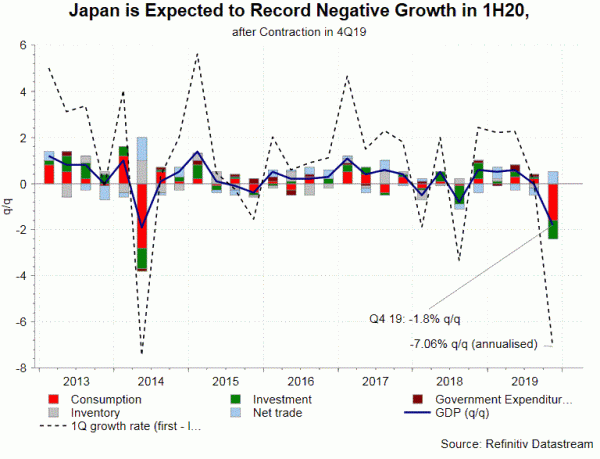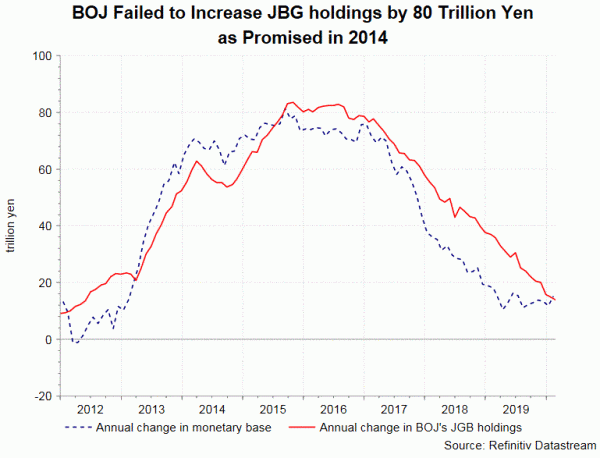A week before the final data, the flash PMI report for Japan gives a glimpse of how the coronavirus outbreak has hurt the country’s manufacturing and services activities. The composite output index slumped to 35.8, compared with 47 in February. Sector-wise, the services index dived to 32.7 in March compared with 46.8 in February, while the manufacturing index fell to 44.8 from February’s 47.8. In short, all indices fell deeper into the contractionary territory. Looking into the sub-indices, “new orders” and new export orders” demonstrated sharper decline than the previous month, suggesting reduction in both domestic and overseas demand. Meanwhile, output prices sub-index also fell to deflation for both manufacturing and services sectors. As a lagging indicator, the employment sub-index drifted to contraction from expansion.
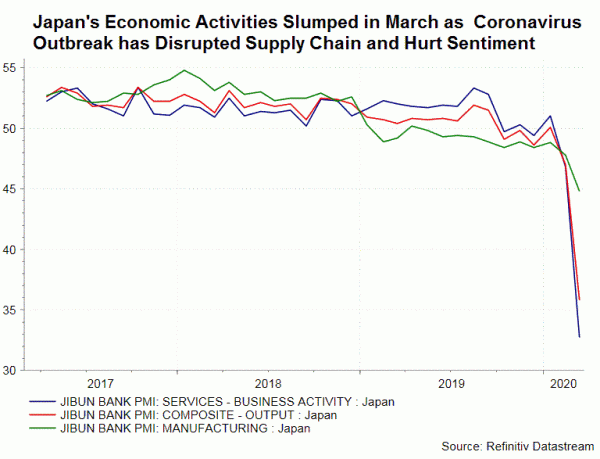 Japan’s economic developments had been subdued before the pandemic. Inflation, excluding fresh food and energy, eased to +0.6% y/y in February, from +0.8% in February. 4Q19 GDP contracted -1.8% q/q, worse than consensus of -1.7% and -1.6% in the prior quarter. The annualized growth rate fell to -7.1% compared with -6.3% in the third quarter. Downside risks have heightened over the past months. Besides the abovementioned PMI report, the headline Tankan diffusion index dived to -20 in March, from -5 in the prior month. It is highly likely that the country will record negative GDP growth in the first half of this year. The situation could remain dismal in the second half as Tokyo Olympic, originally scheduled to begin in July 24, will be postponed.
Japan’s economic developments had been subdued before the pandemic. Inflation, excluding fresh food and energy, eased to +0.6% y/y in February, from +0.8% in February. 4Q19 GDP contracted -1.8% q/q, worse than consensus of -1.7% and -1.6% in the prior quarter. The annualized growth rate fell to -7.1% compared with -6.3% in the third quarter. Downside risks have heightened over the past months. Besides the abovementioned PMI report, the headline Tankan diffusion index dived to -20 in March, from -5 in the prior month. It is highly likely that the country will record negative GDP growth in the first half of this year. The situation could remain dismal in the second half as Tokyo Olympic, originally scheduled to begin in July 24, will be postponed.
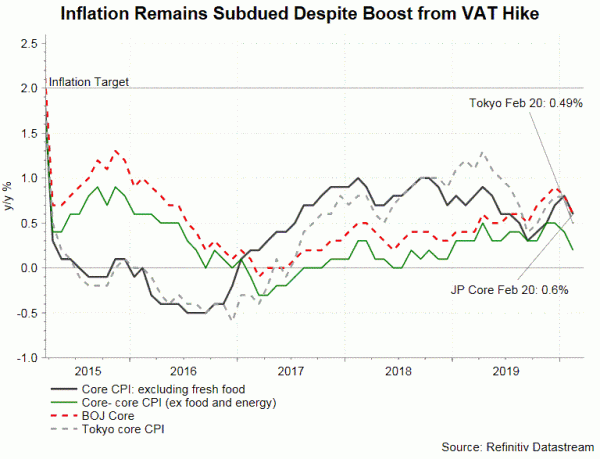 Like other central banks, BOJ has accelerated monetary stimulus measures. Last week, it raised the upper limit for the annual purchase pace of ETFs at 12 trillion yen for now. Yet, it also affirmed that the annual purchase guideline stays unchanged at 6 trillion yen. This confusing guideline might suggest that BOJ is “prepared” to increase purchases when needed but. In a similar vein, BOJ also raised the upper limit of J-reit purchase to 180B yen, while maintaining its annual purchase guideline at 90B yen. BOJ noted that it will “take additional monetary easing steps as needed without hesitation with a close eye on the impact from the coronavirus epidemic for the time being”. These are in additional to existing policy of leaving the policy rate at -0.1% and managing the 10-year JGB yield at about 0% (yield curve control). We are skeptical of the effectiveness of the “new” measures. Back in 2014, BOJ announced a QE program, increasing JGB holdings by 80 trilion yen per year. However, the target has been missed since 2017. Governor Haruhiko Kuroda admitted in an interview last year that “the 80 trillion yen phrase is a symbol of monetary easing”. The lack of commitment has put BOJ’s credibility at risk.
Like other central banks, BOJ has accelerated monetary stimulus measures. Last week, it raised the upper limit for the annual purchase pace of ETFs at 12 trillion yen for now. Yet, it also affirmed that the annual purchase guideline stays unchanged at 6 trillion yen. This confusing guideline might suggest that BOJ is “prepared” to increase purchases when needed but. In a similar vein, BOJ also raised the upper limit of J-reit purchase to 180B yen, while maintaining its annual purchase guideline at 90B yen. BOJ noted that it will “take additional monetary easing steps as needed without hesitation with a close eye on the impact from the coronavirus epidemic for the time being”. These are in additional to existing policy of leaving the policy rate at -0.1% and managing the 10-year JGB yield at about 0% (yield curve control). We are skeptical of the effectiveness of the “new” measures. Back in 2014, BOJ announced a QE program, increasing JGB holdings by 80 trilion yen per year. However, the target has been missed since 2017. Governor Haruhiko Kuroda admitted in an interview last year that “the 80 trillion yen phrase is a symbol of monetary easing”. The lack of commitment has put BOJ’s credibility at risk.
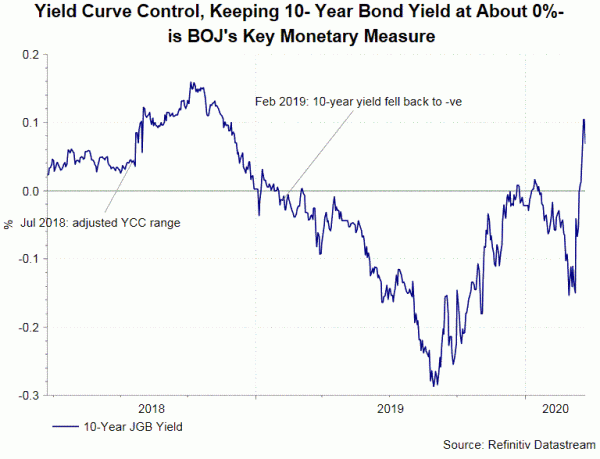 On the fiscal front, the government might embark an emergency economic package worth more than 30 trillion yen. Government spending could be over 15 trillion yen. While fiscal stimulus is necessary in stimulating growth, in particular when monetary tools are exhausted, it could create a crowding out effect. Prime Minister Shinzo Abe has noted that the “huge” stimulus would in part financed by deficit-covering bonds. This could eventually raise the borrowing costs for corporate.
On the fiscal front, the government might embark an emergency economic package worth more than 30 trillion yen. Government spending could be over 15 trillion yen. While fiscal stimulus is necessary in stimulating growth, in particular when monetary tools are exhausted, it could create a crowding out effect. Prime Minister Shinzo Abe has noted that the “huge” stimulus would in part financed by deficit-covering bonds. This could eventually raise the borrowing costs for corporate.




